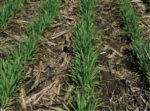Advertise Follow Us
Articles Tagged with ''dry fertilizer''
Take soil tests, select efficient fertilizer products and consider timing and placement to reduce nutrient loss and economically build up soil levels.
Read More
No-Tiller’s Cart Design Delivers High-Speed Dual Fertilizers
Kansas farmer David Holthaus wanted a soil-friendly application system for anhydrous ammonia and granular fertilizer, so he came up with his own solution.
Read More
Switch To Strip-Till, Cover Crops Friendly To Yields And Profits
For Ontario farmer Blake Vince, taking a leap with strip-till practices helped him improve corn yields, preserve soil moisture and reduce expenditures on high-dollar fuel and fertilizer.
Read More
‘Strip Refresher’ Fights Wet Springs, Boosts Emergence
Illinois strip-tiller Todd Mooberry says his invention helps cold, wet soils dry out and warm up faster, allowing for earlier planting and better stands.
Read More
Adding New Layers To Create A No-Till System
Crop diversity, better seeding equipment and using a ‘journal’ to avoid repeating mistakes brings success for North Dakota no-tiller Kevin Larson.
Read More
Ingenious Toolbar Offers Great Capacity, Flexibility For Strip-Tiller
Shane Houck designed a 60-foot-wide, front-folding-frame toolbar for strip-tilling, planting corn and soybeans and sidedressing corn, too.
Read More
Building Spring Strips When It Didn’t Get Done
If a late harvest didn’t allow you to strip-till last fall, making shallower berms and splitting fertilizer this spring can help you stay on track
Read More
$5,000 Grant, Used Parts Lead To Homemade Strip-Till Rig
This 6-row, 30-inch unit drops dry fertilizer along the row and incorporates anhydrous ammonia in one pass for Iowa strip-tiller.
Read More











